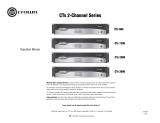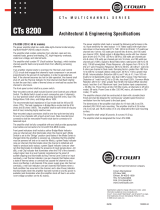
page 15
CTs 2-Channel Power Amplifiers
Operation Manual
NOTE: For detailed information about
these Crown amplifier features, please
consult the Crown Amplifier Application
Guide, available on the Crown website
at www.crownaudio.com
5.1 Protection Systems
Your Crown amplifier provides extensive pro-
tection and diagnostic capabilities, including
thermal level control, fault indicators, high-
pass filtering, DC protect, AC under/over volt-
age protection, inrush limiting, and variable-
speed fans.
5.1.1 Thermal Level Control (TLC)
If the amplifier becomes too hot for safe opera-
tion, the light will shine brightly and TLC will
engage the input compressor. By compressing
the input, the amplifier will not generate as
much heat and will have a chance to cool down.
The degree of compression is proportional to
the amount of overheating. This feature allows
the show to go on, rather than having the
amplifier shut down.
5.1.2 Junction Temperature Simu-
lation (JTS) (CTs 600/1200 only)
JTS circuitry simulates the operation of the
amplifier’s output transistors, and compares it
against the transistors known Safe Operation
Area (SOA). If JTS sees that more power is
about to be asked of the output devices than
they are capable of delivering under the present
conditions, JTS immediately limits the drive
level until it falls within the SOA. Limiting is
proportional and kept to an absolute minimum-
only what is required to prevent the possibility
of output transistor damage.
This level of protection enables Crown to
increase output transistor utilization while also
greatly increasing amplifier reliability.
5.1.3 Fault
The amplifier will light the Fault LED if the
amplifier output stage stops operating. If this
happens, see Section 8 for servicing informa-
tion.
5.1.4 High-Pass Filters
Very low frequency signals contain no useful
musical energy, waste valuable amplifier power
and headroom, and can be damaging to your
speakers. Your Crown amplifier provides high-
pass filters to remove these signals from each
channel’s output.
On the back panel are two 3-position 3rd-order
high-pass filter switches (one per channel) with
selections of Off, 35Hz and 70 Hz.
5.1.5 Low-Pass Filters
Gaussian-approximation ultrasonic filters pre-
vent ultrasonic feedback and HF burnout in
drivers. This type of filter preserves transient
reponse better than a Butterworth filter.
5.1.6 AC Under/Over Voltage
Protection
If the AC line voltage drops below 25% or rises
above 15% of the nominal operating voltage of
the amplifier, the amplifier’s power supply turns
off and the blue Power LED flashes. The ampli-
fier will turn back on when the AC line voltage
returns to safe operating levels (within +15% /
-25%).
5.1.7 Circuit Breaker
A circuit breaker located near the IEC power
inlet protects the amplifier from excessive AC
current draw.
5.1.8 DC Output Servo
The output servo circuit protects your drivers
by eliminating DC offset, even in the presence
of very large asymmetrical signals.
5.1.9 Inrush Limiting
A soft-start circuit in the power supply mini-
mizes the amplifier’s current draw during
power-on.
5.1.10 Variable-speed Fans
Two continuously variable speed fans direct the
airflow through the amplifier for cooling.
5.2 Advanced Features
5.2.1 Switching Power Supply
Crown’s Switching Power Supply minimizes
the amplifier’s weight.
Typical non-switching power supplies require
large, heavy transformers in order to produce
the required power at the output stage. These
transformers must be large to operate at 50 to
60 Hz (standard AC supplied by the power
company).
By contrast, switching power supplies can
operate with a much smaller (and lighter) trans-
former because they first convert the AC up to a
much higher frequency, thereby reducing
waste.
The power supply is voltage-specific, allowing
use in regions using 120V or 240V.
5.2.2 Input Compressor
Prevent input/output overload.
5.2.3 Sleep Circuit
Lowers standby power consumption by shut-
ting down the high-voltage supplies during idle
periods.
NOTE: By default, the sleep circuit is not active
on the CTs 600/1200, but may be activated as a
service option.
5 Advanced Features
and Options























